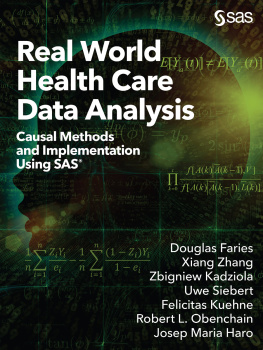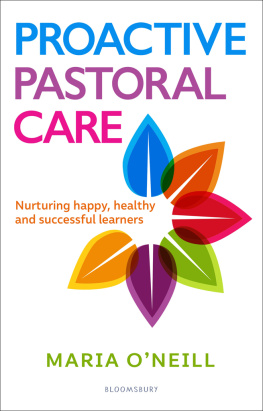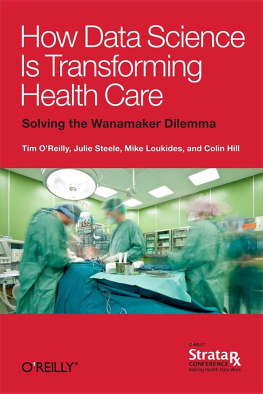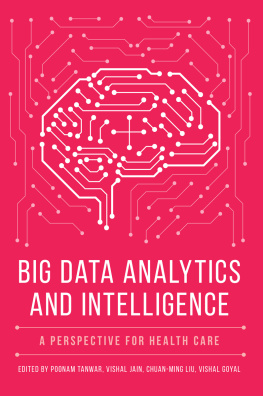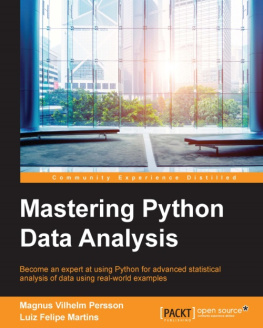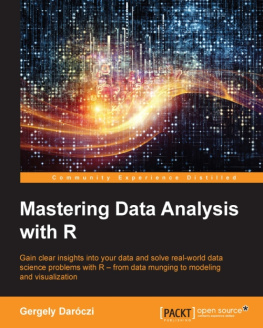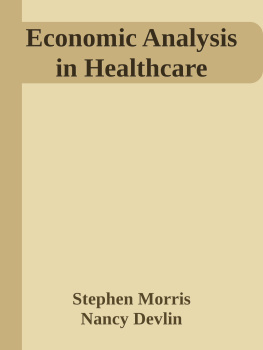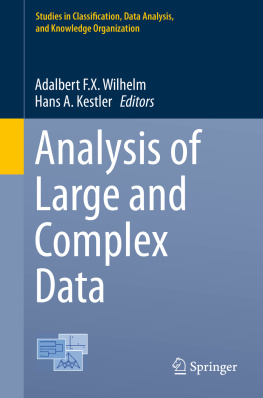Josep Maria Haro - Real World Health Care Data Analysis
Here you can read online Josep Maria Haro - Real World Health Care Data Analysis full text of the book (entire story) in english for free. Download pdf and epub, get meaning, cover and reviews about this ebook. year: 2020, publisher: SAS Institute, genre: Romance novel. Description of the work, (preface) as well as reviews are available. Best literature library LitArk.com created for fans of good reading and offers a wide selection of genres:
Romance novel
Science fiction
Adventure
Detective
Science
History
Home and family
Prose
Art
Politics
Computer
Non-fiction
Religion
Business
Children
Humor
Choose a favorite category and find really read worthwhile books. Enjoy immersion in the world of imagination, feel the emotions of the characters or learn something new for yourself, make an fascinating discovery.
- Book:Real World Health Care Data Analysis
- Author:
- Publisher:SAS Institute
- Genre:
- Year:2020
- Rating:4 / 5
- Favourites:Add to favourites
- Your mark:
- 80
- 1
- 2
- 3
- 4
- 5
Real World Health Care Data Analysis: summary, description and annotation
We offer to read an annotation, description, summary or preface (depends on what the author of the book "Real World Health Care Data Analysis" wrote himself). If you haven't found the necessary information about the book — write in the comments, we will try to find it.
Real World Health Care Data Analysis — read online for free the complete book (whole text) full work
Below is the text of the book, divided by pages. System saving the place of the last page read, allows you to conveniently read the book "Real World Health Care Data Analysis" online for free, without having to search again every time where you left off. Put a bookmark, and you can go to the page where you finished reading at any time.
Font size:
Interval:
Bookmark:
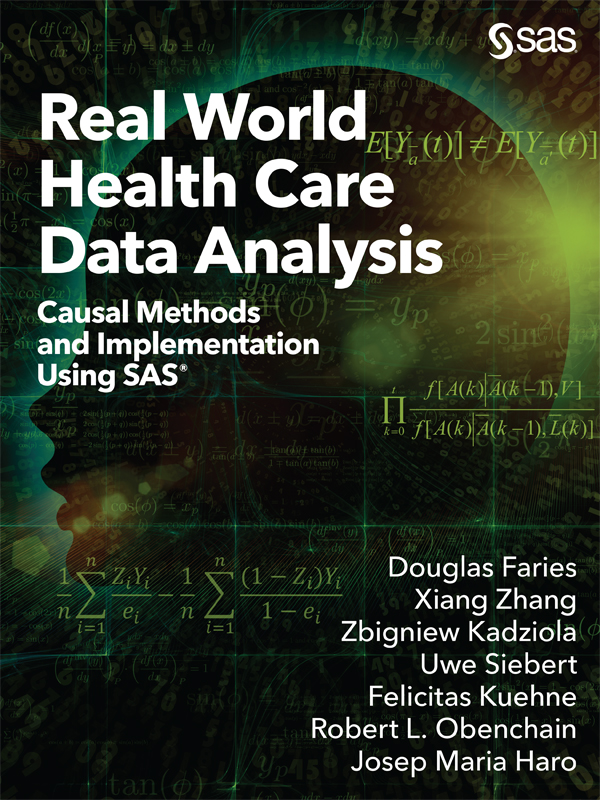
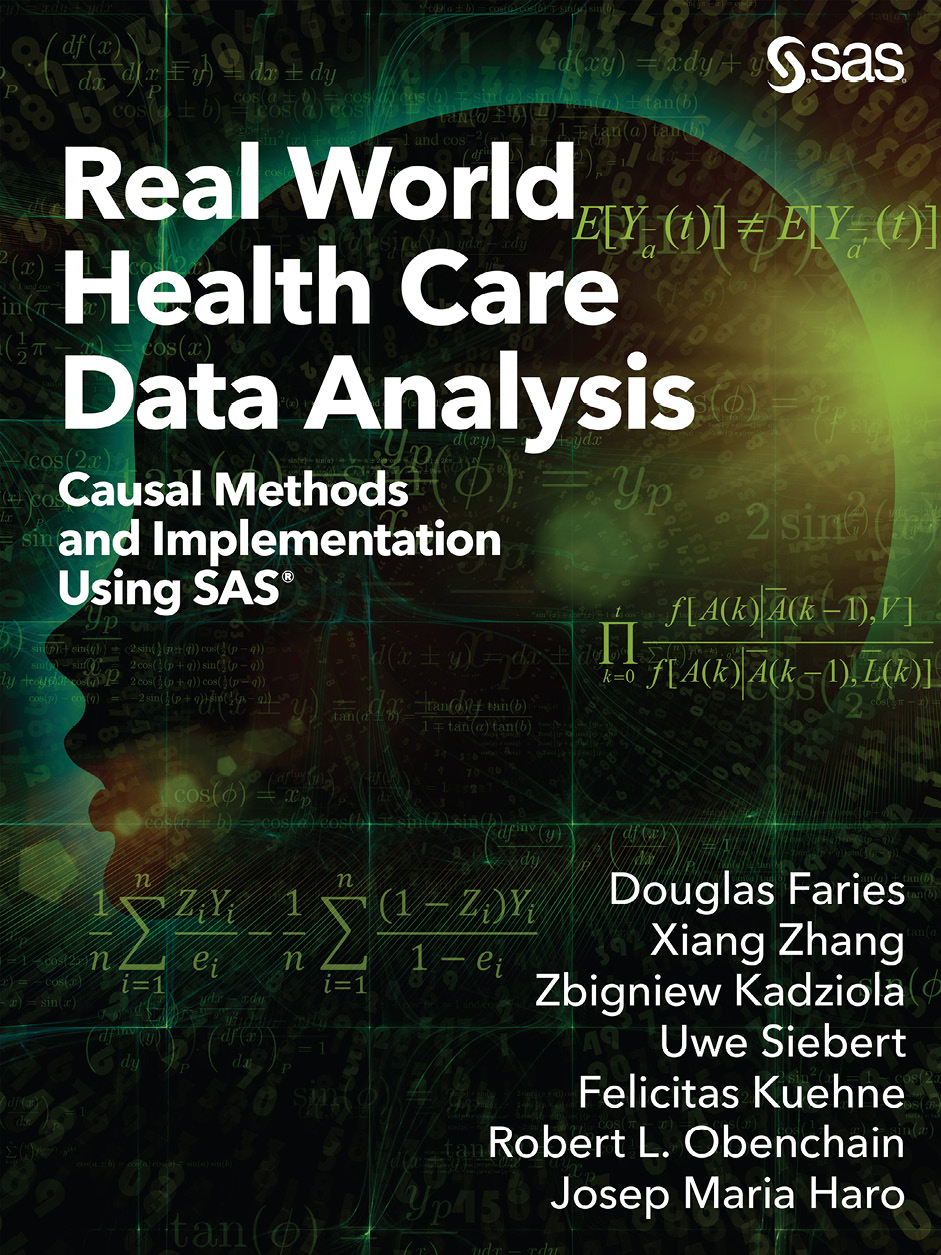
The correct bibliographic citation for this manual is as follows: Faries, Douglas, Xiang Zhang, Zbigniew Kadziola, Uwe Siebert, Felicitas Kuehne, Robert L. Obenchain, and Josep Maria Haro. 2020. Real World Health Care Data Analysis: Causal Methods and Implementation Using SAS . Cary, NC: SAS Institute Inc.
Real World Health Care Data Analysis: Causal Methods and Implementation Using SAS
Copyright 2020, SAS Institute Inc., Cary, NC, USA
ISBN 978-1-64295-802-7 (Hard cover)
ISBN 978-1-64295-798-3 (Paperback)
ISBN 978-1-64295-799-0 (PDF)
ISBN 978-1-64295-800-3 (epub)
ISBN 978-1-64295-801-0 (kindle)
All Rights Reserved. Produced in the United States of America.
For a hard-copy book: No part of this publication may be reproduced, stored in a retrieval system, or transmitted, in any form or by any means, electronic, mechanical, photocopying, or otherwise, without the prior written permission of the publisher, SAS Institute Inc.
For a web download or e-book: Your use of this publication shall be governed by the terms established by the vendor at the time you acquire this publication.
The scanning, uploading, and distribution of this book via the Internet or any other means without the permission of the publisher is illegal and punishable by law. Please purchase only authorized electronic editions and do not participate in or encourage electronic piracy of copyrighted materials. Your support of others rights is appreciated.
U.S. Government License Rights; Restricted Rights: The Software and its documentation is commercial computer software developed at private expense and is provided with RESTRICTED RIGHTS to the United States Government. Use, duplication, or disclosure of the Software by the United States Government is subject
to the license terms of this Agreement pursuant to, as applicable, FAR 12.212, DFAR 227.7202-1(a), DFAR 227.7202-3(a), and DFAR 227.7202-4, and, to the extent required under U.S. federal law, the minimum restricted rights as set out in FAR 52.227-19 (DEC 2007). If FAR 52.227-19 is applicable, this provision serves as notice under clause (c) thereof and no other notice is required to be affixed to the Software or documentation. The Governments rights in Software and documentation shall be only those set forth in this Agreement.
SAS Institute Inc., SAS Campus Drive, Cary, NC 27513-2414
January 2020
SAS and all other SAS Institute Inc. product or service names are registered trademarks or trademarks of SAS Institute Inc. in the USA and other countries. indicates USA registration.
Other brand and product names are trademarks of their respective companies.
SAS software may be provided with certain third-party software, including but not limited to open-source software, which is licensed under its applicable third-party software license agreement. For license information about third-party software distributed with SAS software, refer to http://support.sas.com/thirdpartylicenses .
Contents
About the Book
What Does This Book Cover?
In 2010 we produced a book, Analysis of Observational Health Care Data Using SAS , to bring together in a single place many of the best practices for real world and observational data research. A focus of that effort was to make the implementation of best practice analyses feasible by providing SAS Code with example applications. However, since that time, there have been improvements in analytic methods, coalescing of thoughts on best practices, and significant upgrades in SAS procedures targeted for real world research, such as the PSMATCH and CAUSALTRT procedures. In addition, the growing demand for real world evidence and interest in improving the quality of real world evidence to the level required for regulatory decision making has necessitated updating the prior work.
This new book has the same general objective as the 2010 text to bring together best practices in a single location and to provide SAS codes and examples to make quality analyses both easy and efficient. The main focus of this book is on causal inference methods to produce valid comparisons of outcomes between intervention groups using non-randomized data. Our goal is to provide a useful reference to help clinicians, epidemiologists, health outcome scientists, statisticians, data scientists, and so on, to turn real world data into credible and reliable real world evidence.
The opening chapters of the book present an introduction of basic causal inference concepts and summarize the literature regarding best practices for comparative analysis of observational data. The next portion of the text provides detailed best practices, SAS code and examples for propensity score estimation, and traditional propensity score-based methods of matching, stratification, and weighting. In addition to standard implementation, we present recent upgrades including automated modeling methods for propensity score estimation, optimal and full optimal matching procedures, local control stratification, overlap weighting, new algorithms that generate weights that produce exact balance between groups on means and variances, methods that extend matching and weighting analyses to situations comparison more than two treatment groups, and a model averaging approach to let the data drive the selection of the best analysis for your specific scenario. Two chapters of the book focus on longitudinal observational data. This includes an application of marginal structural modeling to produce causal treatment effect estimates in longitudinal data with treatment switching and time varying confounding and a target trial replicates analysis to assess dynamic treatment regimes. In the final section of the book, we present analyses for emerging topics: reweighting methods to generalize RCT evidence to real world populations, sensitivity analyses and best practice flowcharts to quantitatively assess the potential impact of unmeasured confounding, and an introduction to using real world data and machine learning algorithms to identify treatment choices to optimize individual patient outcomes.
Is This Book for You?
Our intended audience includes researchers who design, analyze (plan and write analysis code), and interpret real world health care research based on real world and observational data and pragmatic trials. The intended audience would likely be from industry, academia, and health care decision-making bodies, including the following job titles: statistician, statistical analyst, data scientist, epidemiologist, health outcomes researcher, medical researcher, health care administrator, analyst, economist, professor, graduate student, post-doc, and survey researcher.
The audience will need to have at least an intermediate level of SAS and statistical experience. Our materials are not intended for novice users of SAS, and readers will be expected to have basic skills in data handling and analysis. However, readers will not need to be expert SAS programmers as many of our methods use standard SAS/STAT procedures and guidance is provided on the use of our SAS code.
What Should You Know about the Examples?
Almost every chapter in this book includes examples with SAS code that the reader can follow to gain hands-on experience with these causal inference analyses using SAS.
Software Used to Develop the Books Content
SAS 9.4 was used in the development of this book.
Example Code and Data
Each of the examples is accompanied by a description of the methodology, output from running the SAS code, and a brief interpretation of the results. All examples use one of two simulated data sets, which are available for the readers to access. While not actual patient data, these data sets are based on two large prospective observational studies and designed to retain the analytical challenges that researchers face with real world data.
Font size:
Interval:
Bookmark:
Similar books «Real World Health Care Data Analysis»
Look at similar books to Real World Health Care Data Analysis. We have selected literature similar in name and meaning in the hope of providing readers with more options to find new, interesting, not yet read works.
Discussion, reviews of the book Real World Health Care Data Analysis and just readers' own opinions. Leave your comments, write what you think about the work, its meaning or the main characters. Specify what exactly you liked and what you didn't like, and why you think so.

